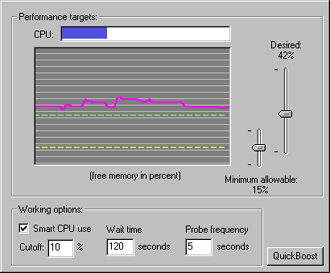|
Sections
 CPU meter CPU meter
 Memory graph Memory graph
 Options Options
 QuickBoost QuickBoost
Related articles
 The Manager The Manager
 Statistics Statistics
 Optimize Optimize
Quick links
 Table of Contents Table of Contents
 Questions Questions
|
|
Settings window

The CPU meter
The CPU meter, at the top left of the screen, shows how much of your computer's
processing ability is currently being used. The meter updates every few seconds
(depending on your settings), so you won't see it react immediately to changes
in your system.
The free memory graph
The free memory graph illustrates how much memory, in percent, has been free on
your computer over time. The far-right portion of the graph is the most recent.
You can use the sliders to the right, entitled "Desired" and "Minimum allowable,"
to adjust how MemoryBoost manages your memory. MemoryBoost tries to maintain the
desired amount of memory, represented by the green line on the graph. But sometimes,
as shown in the picture, it will allow free memory to drop below the desired amount
as long as it does not affect your computer's performance. The minimum allowable
amount is much more serious. When memory drops below this amount, MemoryBoost will
immediately spring into action to boost memory above this amount.
It is important to set your desired and minimum free memory levels wisely. If you
set them too high, MemoryBoost will often work to improve your memory which is not
really necessary. If they are set too low, your computer may run out of memory before
MemoryBoost has a chance to work. Fortunately, you have a lot of discretion in setting
these values, and MemoryBoost restricts you from setting values that will hurt your
computer's performance. Generally speaking, you can select any value that MemoryBoost
will allow. We recommend setting your desired free memory to around 40% and your
minimum to around 15%. These values and similar ones have been empirically
discovered to produce best performance.
Working options
These options let you set how often MemoryBoost will try to regain more memory,
and under what circumstances. First, the "Probe frequency" allows you to set how
often MemoryBoost checks your memory and updates its statistics (and the CPU meter).
You can change this value to anything you want in seconds. We recommend 5 seconds;
you can set it as low as 1 and as high as you like. If the value is very high, MemoryBoost
will not check your memory very often and may let your memory slip below desired or
minimum levels. You should therefore probably not set this value to anything greater
than 10 seconds.
By checking the "Smart CPU use" button, you ensure that MemoryBoost will not try to
reclaim memory when you are working at your computer. When MemoryBoost is running,
you may observe a slight slowdown in your computer. This is why MemoryBoost tries to
work only when you are away from your computer, when it doesn't really matter if the
system slows down a little. Checking the smart CPU button enables this feature;
MemoryBoost will check to make sure your machine is not in use before it starts to
work.
MemoryBoost checks by seeing how much of your CPU is in use. If you're away from your
computer, probably not very much is in use. MemoryBoost will work when the CPU level
is below the cutoff level, which you can specify. The default is 10%. Setting a high
CPU cutoff lets MemoryBoost work even when your computer is working. Low means that
your computer really has to be silent before MemoryBoost will work. We recommend
settings between 10 and 20 percent.
Because your CPU fluctuates constantly (when you start a program, it may be high for
a second but then low again), MemoryBoost watches your CPU over a period of time to
make sure you're really not using your computer (not just that you've stopped for a second).
The "wait time" setting instructs MemoryBoost to watch your CPU for a certain time before
acting. If the CPU is below the CPU cutoff for the entire wait time, then MemoryBoost
will act. You can set this value to whatever you want, in seconds. By default it is
set at 120 seconds (2 minutes).
QuickBoost
The QuickBoost button lets you run QuickBoost from within the Manager. QuickBoost
will allow you to immediately reclaim some memory. For more information on QuickBoost,
please visit the QuickBoost help section. When you click
on the QuickBoost button, you'll see the QuickBoost window appear.
|

